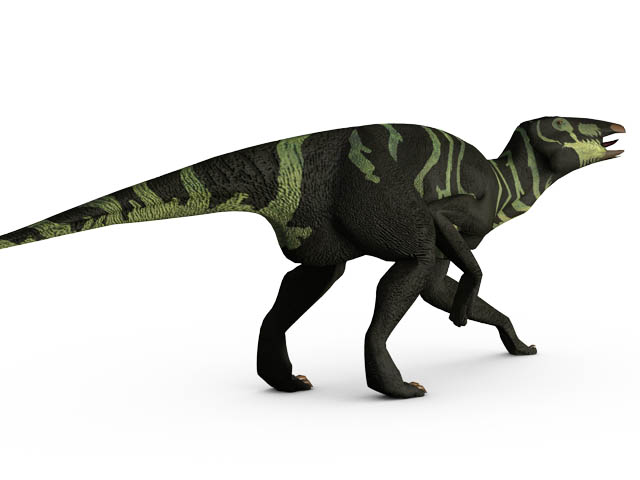Even if you despise science, and hate palaeontology with special fervour, you have probably noticed that these days, pretty much everyone accepts that birds descended from dinosaurs. You may have also noticed that a large number of theropods are now regularly depicted with feathers. You probably looked at your calendar realized that it wasn’t April Fools Day, and wondered what was going on. How did this epiphany come about?
In the last post, I went over the
Thecodont hypothesis, its inherent weakness as a scientific theory, and its wide and unquestioned acceptance. Well, in science, the status
quo is never safe forever. Enter John H.
Ostrom.
Ostrom was a paleontologist working at Yale University. In 1969, he published a groundbreaking description of
Deinonychus antirrhopus (
Osteology of Deinonychus antirrhopus, an unusual theropod from the Lower Cretaceous of Montana ), a Cretaceous
dromeosaur first discovered in Montana in 1931. In
Osteology of Deinonychus,
Ostrom noted 22 similarities between
Deinonychus and Archaeopteryx, the “first bird.” This served to re-ignite the debate on bird origins, and
Ostrom followed up his work with several more publications during the 1970’s, culminating in another major work in 1976 (
Archaeopteryx and the origin of birds).
There were other theories emerging at the same time to challenge
Ostrom’s hypothesis. In 1972, Alick Walker, published an article proposing the
crocodylomorph hypothesis (
New light on the origin of birds and crocodiles) , connecting birds with
Crocodylomorphs, a group of crocodiles and reptiles closely related to them. However, Walker was only ever able to find 15-20 similarities between
Crocodylomorphs and birds, compared to an eventual 70 or more similarities with
theropod dinosaurs.
The road to acceptance of the newly re-emerging theory of bird origins proved to be rocky. In 1985, Astronomer Sir Fred Hoyle claimed that the discovery of Archaeopteryx in Germany had actually been an elaborate hoax, with feathers having been imprinted in the rock around real reptilian skeletons after their discovery. However, further discoveries and testing of the Berlin and London specimens proved Hoyle’s claim groundless.
The floodgates having been opened, research into the connection between birds and dinosaurs began. In 1986, Jacques Gauthier, a curator of the Peabody museum at Yale, published a detailed
cladistic analysis of
theropod dinosaurs. His results upheld John
Ostrom’s earlier work. He concluded that, while crocodiles were the closest living relative of birds, extinct
theropod dinosaurs were, in fact, much more closely related. This helped sink Alick Walker’s
Crocodylomorph hypothesis.
Although evidence for the bird dinosaur link was mounting, it was not until the mid to late 1990’s that acceptance of the hypothesis became widespread in the public. In 1996, rumours began to spread about a dinosaur named
sinosauropteryx, discovered in the
Yixian fossil formation, in northeastern China. Then, at the 1996 meeting of Vertebrate Palaeontologists at the American Museum of Natural History, the secret was revealed.
 Sinosauropteryx wasn
Sinosauropteryx wasn’t actually on the agenda, but Phil Currie, then of the Royal
Tyrell Museum in
Drumheller Alberta, had brought pictures. The palaeontology community was on fire. In 1998,
Ji Qiang, Phil Currie, Mark
Norrell and
Ji Shu-An published their findings in
Two feathered dinosaurs from northeastern China. Phil Currie called the China finds “the most important dinosaur discovery of this century," and continued, "the credibility of the dinosaur-to-birds theory takes a gigantic leap ahead with these specimens."
As the flow of new specimens from
Yixian continued, other research further reinforced the dinosaur-bird connection. In 1999, a group of researchers published a paper (
Beta-keratin specific immunological reactivity in feather-like structures of the Cretaceous Alvarezsaurid, Shuvuuia deserti) announcing that, through chemical analysis, they had determined that the feather-like structures on
Shuvuuia deserti, a Cretaceous
theropod, were similar in composition to the feathers of modern birds. They had found the decay products of the protein Beta-Keratin, a major component of modern feathers, in the fossilized feathers of
Shuvuuia deserti. Further strengthening the find was the lack of Alpha-Keratin, found in reptile skin, but not in the feathers of modern birds.

In 2005, Mary
Higby Schweitzer of North Carolina State University announced that she and her team had recovered preserved soft tissue from the femur of a Tyrannosaurus recovered from the Hell Creek formation in Montana. In 2007 Schweitzer‘s team announced that they had sequenced a protein from the soft tissue. Analysis showed that it most closely resembled chicken collagen, followed by proteins found in frogs and newts. The team also found
medullary tissue, grown inside the bones of female birds as a source of calcium for eggshell production.
The theory that birds are descended from
theropod dinosaurs is now widely accepted in the world of palaeontology. That
isn’t to say that there is no dissent. Alan
Feduccia, a
paleornithologist from the University of North Carolina.
Feduccia claims that birds and
theropods evolved from the same, common ancestor. One particular element of dinosaur-bird evolution he is critical of is the ground-up development of flight.
However, let us reflect back for a moment on the evidence we have seem supporting the hypothesis. The inherent similarities between birds and
theropods are backed up by a growing mountain of physical and chemical evidence. The debate on bird origins is not really over, but perhaps somewhere, a fat lady is warming up for an upcoming performance.
This is part two of a three part series on the history of research into the link between birds and theropod dinosaurs. This is by far the longest section, dealing with the re-emergence of the theropod origin hypothesis.Sources:Dino-Birds - The Evolution of Birds from Dinosaurs - http://www.surfbirds.com/mb/Features/dinosaurs/dino-birds-arch.html
Yale Bulletin - http://www.yale.edu/opa/v32.n16/story5.html
The origin and evolution of birds - http://www.geologyrocks.co.uk/tutorials/origin_and_early_evolution_birds
Wikipedia: Tyrannosaurus - http://en.wikipedia.org/wiki/Tyrannosaurus#_note-3
Wikipedia: Alick Walker - http://en.wikipedia.org/wiki/Alick_Walker
The Life of Birds - http://www.pbs.org/lifeofbirds/evolution/index.html
Welcome to Dinotopia - http://technology.newscientist.com/article/mg18625001.900
NYT: Reptiles’ Link to Birds May be Settled - http://query.nytimes.com/gst/fullpage.html?res=940DE1D9163DF937A15755C0A96E948260&sec=&spon=&pagewanted=1
Wikipedia: Jacques Gauthier - http://en.wikipedia.org/wiki/Jacques_Gauthier#_note-1
T.Rex Soft Tissue Preserved - http://news.nationalgeographic.com/news/2005/03/0324_050324_trexsofttissue.html
Review of Ostrom’s Studies of Archaeopteryx - http://elibrary.unm.edu/sora/Wilson/v089n03/p0488-p0492.pdf
Wikipedia: Shuvuuia - http://en.wikipedia.org/wiki/Shuvuuia_deserti#_note-schweitzer1999
Wikipedia: Feathered Dinosaurs - http://en.wikipedia.org/wiki/Feathered_dinosaurs
Did Birds Evolve from Dinosaurs? - http://8e.devbio.com/article.php?ch=16&id=161
John H. Ostrom, Influential Paleontologist, Is Dead at 77 - http://www.nytimes.com/2005/07/21/nyregion/21OSTROM.html
EvoWiki: J. Alan Feduccia - http://wiki.cotch.net/index.php/Alan_Feduccia















 A few months ago, I got in touch with Roger Smith, the owner of Dinosaurnews.org, a really wonderful webzine, that features all the latest and greatest Paleontology news. Roger runs Dinosaurnews completely nonprofit, and I started wondering what I could do to help. We started throwing around the idea of a fundraiser, to help support Dinosaurnews, and help it to reach an even broader audience.
A few months ago, I got in touch with Roger Smith, the owner of Dinosaurnews.org, a really wonderful webzine, that features all the latest and greatest Paleontology news. Roger runs Dinosaurnews completely nonprofit, and I started wondering what I could do to help. We started throwing around the idea of a fundraiser, to help support Dinosaurnews, and help it to reach an even broader audience. Duria Antiquior, By Henry De le Beche
Duria Antiquior, By Henry De le Beche  by Benjamin Waterhouse Hawkins
by Benjamin Waterhouse Hawkins by Alice B. Woodward
by Alice B. Woodward


 In the last post, I went over the
In the last post, I went over the 






